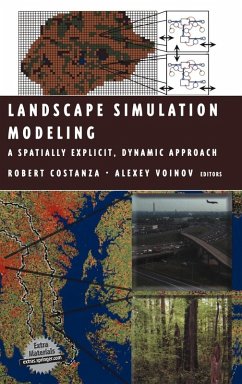When managers and ecologists need to make decisions about the environment, they use models to simulate the dynamic systems that interest them. All management decisions affect certain landscapes over time, and those landscapes are composed of intricate webs of dynamic processes that need to be considered in relation to each other. With widespread use of Geographic Information Systems (GIS), there is a growing need for complex models corporating an increasing amount of data. The open-source Spatial Modeling Environment (SME) was developed to build upon common modeling software, such as STELLA (R), and Powersim (R), among others, to create, run, analyze, and present spatial models of ecosystems, watersheds, populations, and landscapes. In this book, the creators of the Spatial Modeling Environment discuss and illustrate the uses of SME as a modeling tool for all kinds of complex spatial systems. The authors demonstrate the entire process of spatial modeling, beginning with the conceptual design, continuing through formal implementation and analysis, and finally with the interpretation and presentation of the results. A variety of applications and case studies address particular types of ecological and management problems and help to identify potential problems for modelers. Researchers and students interested in spatial modeling will learn how to simulate the complex dynamics of landscapes. Managers and decision makers will acquire tools for predicting changes in landscapes while learning about both the possibilities and the limitations of simulation models. The enclosed CD contains SME, color illustrations and models and data from the examples in the book.
The world consists of many complex systems, ranging from our own bodies to ecosystems to economic systems. Despite their diversity, complex systems have many structural and functional features in common that can be effectively si- lated using powerful, user-friendly software. As a result, virtually anyone can - plore the nature of complex systems and their dynamical behavior under a range of assumptions and conditions. This ability to model dynamic systems is already having a powerful influence on teaching and studying complexity. The books in this series will promote this revolution in "systems thinking" by integrating computational skills of numeracy and techniques of dynamic mod- ing into a variety of disciplines. The unifying theme across the series will be the power and simplicity of the model-building process, and all books are designed to engage the reader in developing their own models for exploration of the dyn- ics of systems that are of interest to them. Modeling Dynamic Systems does not endorse any particular modeling paradigm or software. Rather, the volumes in the series will emphasize simplicity of lea- ing, expressive power, and the speed of execution as priorities that will facilitate deeper system understanding.
Hinweis: Dieser Artikel kann nur an eine deutsche Lieferadresse ausgeliefert werden.
The world consists of many complex systems, ranging from our own bodies to ecosystems to economic systems. Despite their diversity, complex systems have many structural and functional features in common that can be effectively si- lated using powerful, user-friendly software. As a result, virtually anyone can - plore the nature of complex systems and their dynamical behavior under a range of assumptions and conditions. This ability to model dynamic systems is already having a powerful influence on teaching and studying complexity. The books in this series will promote this revolution in "systems thinking" by integrating computational skills of numeracy and techniques of dynamic mod- ing into a variety of disciplines. The unifying theme across the series will be the power and simplicity of the model-building process, and all books are designed to engage the reader in developing their own models for exploration of the dyn- ics of systems that are of interest to them. Modeling Dynamic Systems does not endorse any particular modeling paradigm or software. Rather, the volumes in the series will emphasize simplicity of lea- ing, expressive power, and the speed of execution as priorities that will facilitate deeper system understanding.
Hinweis: Dieser Artikel kann nur an eine deutsche Lieferadresse ausgeliefert werden.
From the reviews:
"This book is a much-needed addition to the geospatial modeling literature, providing theoretical and practical information ... . this is a valuable contribution to the literature on dynamic spatial modeling in particular, and integrated land-change research in general. ... The clearly articulated unifying theme ... and the fact that all the case studies utilize the same software, make for a well-constructed, compelling, informative, and interesting read. I will certainly evaluate this approach and program for my own work." (Maggi Kelly, Environment and Planning, Vol. 32 (2), 2005)
"Landscape Simulation Modeling ... makes a significant contribution by directly incorporating space into existing simulation modeling approaches for a greater understanding of landscape systems. ... this is an excellent book. The content is comprehensive and the text written in a simple and clear style ... . the book will also appeal to many multidisciplinarypractitioners ... . This book should be a required reading for anyone interested either casually or deeply in the design and implementation of spatial simulation models ... ." (Shivanand Balram, Suzana Dragicevic, Ecological Economics, Vol. 52 (1), 2005)
"This book is a much-needed addition to the geospatial modeling literature, providing theoretical and practical information ... . this is a valuable contribution to the literature on dynamic spatial modeling in particular, and integrated land-change research in general. ... The clearly articulated unifying theme ... and the fact that all the case studies utilize the same software, make for a well-constructed, compelling, informative, and interesting read. I will certainly evaluate this approach and program for my own work." (Maggi Kelly, Environment and Planning, Vol. 32 (2), 2005)
"Landscape Simulation Modeling ... makes a significant contribution by directly incorporating space into existing simulation modeling approaches for a greater understanding of landscape systems. ... this is an excellent book. The content is comprehensive and the text written in a simple and clear style ... . the book will also appeal to many multidisciplinarypractitioners ... . This book should be a required reading for anyone interested either casually or deeply in the design and implementation of spatial simulation models ... ." (Shivanand Balram, Suzana Dragicevic, Ecological Economics, Vol. 52 (1), 2005)








